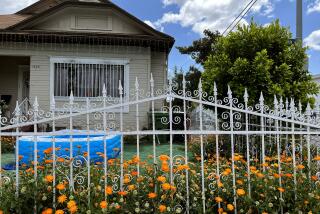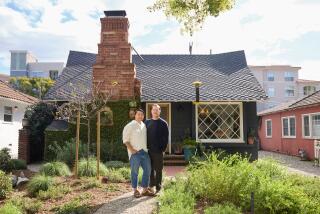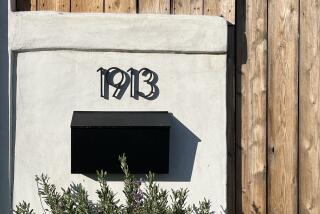Glass Block Design Is Shining Again
- Share via
When you want to capture light and a dramatic feeling of openness while maintaining privacy, glass block can be a smart solution that exudes a certain retro glamour.
A rugged material, glass block has moved beyond its utilitarian roots. Once used primarily in commercial and industrial settings, it’s at home these days in windows, room dividers, shower enclosures and even flooring.
O’Neil & Manion Architects recently used a wall of glass block to maximize light without sacrificing privacy in a new kitchen in Chevy Chase, Md.
“It was an efficient and elegant way to achieve the best of both possible worlds,” says Sara O’Neil-Manion.
The husband-and-wife team from Bethesda, Md., praises the sleek modernity of glass block’s prismatic quality when lighted from behind. They also admire the refractive qualities that allow it to cast patterns on counter tops and adjacent walls.
“Glass block admits light but blocks undesirable views,” says O’Neil-Manion.
In the kitchen, they created a small but efficient open plan that overlooks a family room and backyard garden. Although the work space is about 10 by 12 feet, the room appears larger because of a 10-foot ceiling.
The translucent blocks stretch in a tall, vertical grid along the side wall and form a back splash below the cabinets and behind the cooking surface.
“It’s a tough material, impervious to heat,” says Bill Manion. Indeed, glass block is bulletproof.
Bob DeGusipe is glass-block marketing manager for Pittsburgh Corning Corp., the sole U.S. manufacturer of the material. Its energy efficiency is about equal to that of a same-size, high-quality, double-pane window, he says. So is its price, which runs $20 to $45 per square foot including installation.
Glass block, usually 3 to 4 inches thick, is basically two half-bricks fused around an air pocket. It is available in a variety of sizes, shapes and patterns, which are stamped on the inner face of the molten bricks while they’re in molds.
Patterns “let you see colors and to some extent shape, but details are blurred,” left to the imagination, says O’Neil-Manion. Waves and flutes offer the least visual distortion. Dimples, diamonds and icicle patterns are more opaque, while ribbed and crisscross designs are the ultimate in privacy and light diffusion.
Unlike sash windows, glass blocks are fixed in position. For ventilation, you’ll have to add a vent or hopper window.
First patented in 1887 in France, round glass blocks were used as pavers in ships’ decks and European city streets. They were a staple in labs and factories and institutional settings. When architect Pierre Chareau used them for his revolutionary 1932 “Maison de Verre” (Glass House) in Paris, ribbons of glass block became an acceptable material for avant-garde residential use.
Square glass blocks as we know them are an American innovation dating to the ‘30s. But half a century later, demand had dropped so much that in 1979, Pittsburgh Corning planned to stop production. Thanks to a combination of factors--including the urban loft movement; the slick TV series “Miami Vice,” set amid the city’s Art Deco architecture; and a write-in campaign by leading architects--the production line kept rolling.
“Sales have risen 45% in the past three years,” says Steve Boesch of Baltimore, president of Glass Block of America Inc., the product’s Northeast distributor.
Architects like glass block because “it allows you to play with the notion of transparency,” says Robert Cole of Cole Prevost in Washington.
“You get the translucence of glass--the value of the light--plus refracted imagery,” he says.
What’s more, says his wife and partner, interior designer Sophie Prevost, “the graphic quality--a grid made up of squares or rectangles--makes a powerful design statement.”
O’Neil-Manion sees another admirable feature of glass block. In the kitchen, which faces east, “the first light of morning comes into the room.” With those sunbeams streaming through, the window, she says, “you get a diffuse and luminous glow.”


